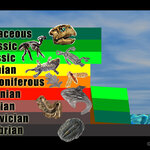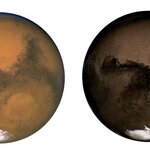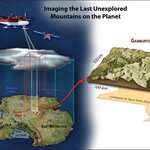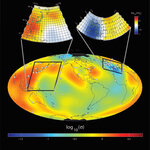Geology

Back in 2005, when a massive 35-mile-long rift broke open in the Ethiopia desert some geologists controversially claimed that a new ocean was forming as two parts of the African continent pulled apart.
Currently, scientists from several countries have supposedly confirmed that the volcanic processes at work beneath the Ethiopian rift are nearly identical to those at the bottom of the world's oceans, and the rift may likely be the beginning of a new sea.
Published in the latest issue of Geophysical Research Letters, the new study suggests that the highly active volcanic boundaries along the…

If you're a child of the 1970s you remember peak oil - it was a book that claimed by 1992 we were going to reach maximum capacity and then it would gradually become more scarce. If you're a fan of science fiction, it meant a world where oil was worth more than gold and we put machine guns on cars to fight over stuff. More likely, we would come up with an alternative, but not before government lobbyists got subsidies for things we know won't work.
Peak oil hasn't happened yet but it's still being discussed. Like that guy on the corner yelling the end of the world is near,…

Dating can be a difficult task, a daunting challenge for men and women the world over. It becomes especially difficult when what you're trying to date is extremely ancient.
I'm not talking about romantic dates with seniors though, I don't have many tips there I'm afraid, although good personal hygiene and being a good listener will probably count in your favour.
I'm talking mainly about the dating of rocks. This isn't as romantic as the other kind of dating, but with both kinds there's a chance you'll get your rocks off. At first, geologists didn't really have much to go on when it came to…

Should you use sand for stream restoration? Common wisdom said no, because it disrupts salmon spawning, researchers have successfully built and maintained a scale model of a living meandering gravel-bed river in the lab and found that sand is indispensable for helping to build point bars and to block off cut-off channels and chutes--tributaries that might start and detract from the flow and health of the stream.
The significance of vegetation for slowing erosion and reinforcing banks has been known for a long time, but this is the first time it has been scientifically…

Committees and organizations usually start for the right reasons but over time they need to become self-perpetuating.
The International Commission on Stratigraphy (ICS) has managed to milk entire decades out of deciding the boundary dates for the Quaternary Age, which covers both the ice age and moment early man first started to use tools, and it seems they have finally voted on an answer.
Voting in science? Indeed, they have formally agreed to move the boundary dates for the prehistoric Quaternary age by 800,000 years, reports the Journal of Quaternary Science.
In…

Some scientists believe that Mars is red due to rocks being rusted by water that once flooded the planet.
That is not the case, say recent laboratory studies which show that red dust may be formed by ongoing grinding of surface rocks and liquid water need not have played any significant role in the formation process. The data were presented at the European Planetary Science Congress by Dr Jonathan Merrison.
Accurate knowledge of the composition and mineralogy of the planet is vital in understanding the structure and evolution of the near-surface environment and its interaction with the…

An international team of scientists has not only verified the existence of a mountain range that is suspected to have caused the massive East Antarctic Ice Sheet to form, but also has created a detailed picture of the rugged landscape buried under more than four kilometers (2.5 miles) of ice.
"Working cooperatively in some of the harshest conditions imaginable, all the while working in temperatures that averaged -30 degrees Celsius, our seven-nation team has produced detailed images of last unexplored mountain range on Earth," said Michael Studinger, of Columbia University's Lamont-Doherty…

This story caught my eye.
"China currently accounts for 93 percent of production of so-called rare earth elements — and more than 99 percent of the output for two of these elements, dysprosium and terbium, vital for a wide range of green energy technologies and military applications like missiles."
"In each of the last three years, China has reduced the amount of rare earths that can be exported. This year’s export quotas are on track to be the smallest yet. But what is really starting to alarm Western governments and multinationals alike is the possibility that exportswill be further…

As I start my 5th semester here at Auburn University, I will again be teaching introductory labs. I would not say I have a passion for teaching, but it is my deepest desire for the students I teach to learn something about their planet and maybe even consider Geology as a career. However, with the hundreds of students that have passed through my classroom, Only a small handful have been enthusiastic about it. Even a smaller number have switched to major (or minor) in it.
Now, its neither my job as a TA to recruit new majors, nor is it my desire. I firmly believe you should pursue what…

A team of scientists from Oregon State University has created the first global three-dimensional map of electrical conductivity in the Earth's mantle and their model suggests that that enhanced conductivity in certain areas of the mantle may signal the presence of water.
What is most notable, the scientists say, is those areas of high conductivity coincide with subduction zones – where tectonic plates are being subducted beneath the Earth's crust. Subducting plates are comparatively colder than surrounding mantle materials and thus should be less conductive. The answer, the researchers…